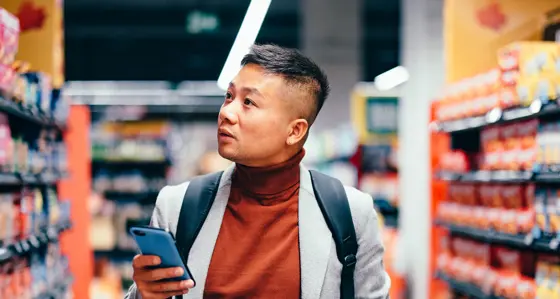
How to win more customers with a sustainable store proposition
4 min read 24 June 2024
The world is feeling the impacts of climate change, which has brought into sharp focus the importance of being a conscious consumer and similarly a conscious retailer.
Over the last few years, we’ve seen a shift in buying trends. Consumers are adapting to more sustainable shopping habits and are demanding the same from the brands and retailers they buy from. 44% of global consumers are more likely to buy from a brand with a clear commitment to sustainability. The opportunity for retailers to win customers through a sustainable store proposition is clear.
To respond to consumers and capture this new market, many retailers have gone public in their commitment to sustainability. Business strategies are now incorporating sustainability alongside traditional financial and operational priorities, with many recognising the need to galvinize action and cross-industry collaboration across store estates to achieve and communicate these goals. For example, H&M, Ikea, Kingfisher and Walmart have committed to the Race to Zero - a pledge to halve GHG emissions by 2030 and achieve net zero by 2050.
This is leading many retailers to ask questions such as:
-
- How can we communicate that sustainability is important to us through our physical stores?
- How does a company reconcile store expansion while reducing/removing carbon impact?
- How can stores boost sustainability in an omnichannel world?
- How can the business case for a sustainable store stack up to justify the upfront cost?

Traditionally there are six phases in the product lifecycle; Source, Make, Move, Sell, Use and Dispose. The most environmentally demanding aspect of a product lifecycle is typically not considered to be the Sell phase (i.e. in-store / online sales activity), however, through an effective sustainable store strategy you can reduce the strain on the other phases by utilising the point of contact with the customer. For instance, through store micro-fulfilment strategies (e.g. in-store pick up, designated collection point for reverse logistics) you can reduce the strain of shipping and returns. Customer education, in-store services, and communication (e.g. repair, recycling) helps to change hearts and minds of the customer, reducing the impact within the Use and Dispose Phases - both of which significantly contribute to Scope 3 Emissions.
Stores can supercharge sustainability efforts to the environment, for instance; more energy efficient utilities, sustainable materials in store (e.g. fixtures, casework / furnishings, display materials such as hangers) or customer consumables (e.g. shopping bags), and waste reduction through better forecast accuracy and inventory aid.
Lastly, stores can be designed to drive a positive social impact, whether that be via the use of space for sustainable collaborations, local community use or educating the customer / colleagues to encourage sustainable behaviours.
Whilst landing the business case for a sustainable store can be difficult, a ‘save to invest’ model can be used to unlock investment to reinvest into sustainable initiatives. For example, generating savings from energy usage reduction and reduced waste to invest in a more sustainable store design, operational processes, and communications.
Done well, the save to invest model can compound the sustainability impact, ultimately driving footfall and increasing revenue.
We can help supercharge sustainability through your stores, bringing deep expertise across our sustainable store framework:
- Our Supply Chain and Procurement experts can help you bring transparency across your network, optimise for Sustainability, and drive a fundamental shift in the role of procurement to elevate Sustainability in buying decisions.
- Our Store Transformation capability can help you define your sustainable store strategy, from the materials you use to build a new store, to how you operate it in the most sustainable way – based on variables such as store location, product, and size to develop a robust business case for change.
- Our Customer Experience team can help you design an instore experience that embeds your sustainability message and increases customer loyalty.
- Our Sustainability team can help you achieve your sustainable store transition, enabling you to measure, manage and improve across all sustainability metrics throughout the value chain.
- Our Energy team can work with you to procure and optimise your energy needs both now and in the future.
Together, we can help you define your sustainable store of the future, leveraging our deep understanding of the retail industry, our leading sustainability capabilities, and proven track record of global implementation at scale. If you’d like to discuss further, please get in touch with Becks Grainger or Curtis Gates.
Related Insights

Preparing for the EU's regulation on deforestation-free products
Is your supply chains prepared for the incoming EU Deforestation Regulation? In this article we share what you need to know in preparation for the new regulation, and how Baringa can help you.
Read more
Achieving the benefits of a multi-brand product portfolio
Download our blog on achieving the benefits of a multi-brand product portfolio.
Read more
Trading team optimisation: time to add value
Trading team optimisation: How team structures and ways of working can help trading teams make fast, informed decisions.
Read more
Become digital podcast: Episode 2 - Pret a Manger
Baringa are joined by Pret a Manger to discuss their digital journey, strategies, response to Covid-19, Pret's coffee subscription service and more
Read moreRelated Client Stories

Freeing up £500m+ in cost savings for investment in new growth and future value at a global FMCG business
How can you improve margin, boost operational resilience and accelerate innovation across a global business?
Read more
Transforming digital capabilities for one of the UK’s best-loved food and coffee chains
Read about how we put our client’s users first to design market-leading digital products.
Read more
Helping an American personal care company become a truly digital business
How can you prepare for the future of e-commerce?
Read more
Restructuring a FTSE 10 health, hygiene and nutrition business into a multi business unit organisation
Read about restructuring a FTSE 10 health, hygiene and nutrition business into a multi business unit organisation.
Read moreIs digital and AI delivering what your business needs?
Digital and AI can solve your toughest challenges and elevate your business performance. But success isn’t always straightforward. Where can you unlock opportunity? And what does it take to set the foundation for lasting success?